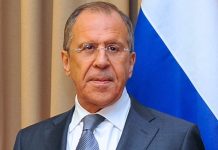
Berlin, FRG (Weltexpress). Part I described the background to Zelensky’s fake “victory plan”, which aims to involve Washington directly in the war against Russia. This second part discusses Russia’s possible reactions to such direct involvement of the USA and other NATO countries in the war in Ukraine.
If it were to come to this and Washington and London were to willingly allow themselves to be harnessed to Zelensky’s war chariot and attack important targets far in Russia’s hinterland with their long-range missiles from Ukrainian territory with the active participation of their soldiers on the ground, then Russia’s obvious first, immediate reaction to this dangerous escalation would be to take out the relevant US satellites in space. This means that they would either be blinded, thrown out of orbit or destroyed. At the same time, US reconnaissance drones would no longer be able to be seen with impunity over the Black Sea without being shot down.
This would be an initial warning that would not yet result in a single dead American soldier. If the US/NATO were to escalate the war with further long-range missiles into the depths of Russia, then – according to statements from the Kremlin – Russian long-range hypersonic missiles could be launched at selected targets in the USA, UK, France and Ramstein in Germany. Ramstein because the US/NATO war in Ukraine is coordinated and controlled from an underground command center there.
In western Ukraine, however, Russia has long since proven that it does not need a tactical nuclear weapon to destroy a command center several stories deep in a bunker where Ukrainian and US/NATO generals had been working together. A Russian hypersonic missile with a conventional warhead was sufficient for this task. At the same time, NATO capitals should bear in mind that the entire collective West, with its alleged “high-tech weapons”, has no means of defending itself against these Russian missiles, because they do not move along a predictable ballistic trajectory.
At the same time, according to the New York Times less hot-headed US advisers have warned the warmongers in the White House of another likely Russian response to US attacks with long-range missiles that goes far beyond the current conflict in Ukraine. The Kremlin could, for example, take the next step of arming the enemies of the US and the West, such as the Houthi rebels in Yemen or Hezbollah in Lebanon, with advanced anti-ship missiles and hypersonic missiles via Iran, which would immediately endanger the entire US fleet and US bases in the Middle East.
The hypersonic missile that the Houthis successfully fired at Israel a few days ago was perhaps intended to give the West a foretaste of this. This missile hit its target, a power station in Tel Aviv, with pinpoint accuracy after a trajectory of over 2,000 kilometers. What was particularly frightening for the Americans and Israelis was that the missile flew over three NATO warships (two US and one French) with state-of-the-art missile defense systems on its flight path over the Red Sea without them even noticing. It was no different for the highly praised Israeli “Iron Dome” defense system, which also failed. This underlines the fact that the West will have neither comparable weapons nor weapons capable of defending against this type of missile in the foreseeable future!
From the New York Times article mentioned earlier in Part I, it appears that US intelligence officials have also expressed deep concerns about the direct and visible involvement of the United States in the Ukrainian war operation. In particular, they fear a global escalation if Russia in turn were to provide technological assistance to Iran that would enable Tehran and its non-state friends – such as the Huthi, Hezbollah and other movements in the region – to successfully attack the American fleet and the bases of US forces in the Middle East.
The consequences of such a scenario are far greater than most people can imagine, as it could set off a chain reaction that would spell the end of Western influence in the Middle East and result in the final collapse of US-dictated Western disorder. At the same time, it is downright absurd the Todessehnsucht (yearning for death) with which Western media speculate in their reporting that it is almost certain that this authorization for long-range missiles against Russia will be granted during the upcoming visit of Selensky.
But let’s go back at this point to the article by Bryen in the Asia Times. In this article, former senior staff director of the US Senate Foreign Relations Committee and later Deputy Under Secretary of Defense for Trade Security Policy, Stephen Bryen, points out that the upcoming Selensky-Biden summit will also fully include Vice President Kamala Harris so that she shares full responsibility for starting a war. No one can say with certainty what the final outcome of this war will be, Bryen writes:
“Will Russia shoot down American satellites? Or use missiles to destroy supply depots in Europe, especially in Poland, which serves as the main hub for the supply of military equipment to Ukraine? Will nuclear weapons be used in Europe?“
Russia has many other options. For example, it could station nuclear weapons in Iran or Syria and grant these countries participation, just as the USA has been doing for decades with its nuclear weapons stationed in Europe, Germany, Italy, Holland, Belgium and Turkey.
According to Bryen, there are many in Washington who are eager to take up the proposals in Zelensky’s “victory plan” for deep strikes on Russian territory because otherwise they fear that Ukraine may lose the war even before the November presidential election. Then the Biden-Harris administration would have to explain why they continued to back a loser, resulting in hundreds of thousands of casualties, instead of seeking a diplomatic solution that would have been easily achievable. With this statement, Bryen highlights the incompetence of the Biden administration, which led to an escalation that could have been easily avoided.
Zelensky’s strategy is easy to see through. He knows that everything is falling apart and that Ukraine will no longer be able to continue the war until winter, as the infrastructure, especially the power supply, is collapsing. His plan is therefore to drag NATO directly into the war. And Washington is foolishly playing along, says Bryen, who assumes that nobody in Europe wants this war, with the exception of the United Kingdom. However, the UK is no longer a major European country, especially as it has no significant land force. Instead, the government in London has built some massively overpriced aircraft carriers that barely function, if at all, instead of strengthening the armed forces as a whole.
The big question, according to Bryen, is why Washington wants to fire missiles at Russia. That could only mean that Biden’s National Security Advisor Jake Sullivan and Secretary of State Antony Blinken know that their Ukraine policy is a disaster. Instead of trying to open a dialog with the Russians, they upped the ante and took enormous risks without knowing how the situation would turn out.
However, contrary to the confidence spread by the mainstream media, the unreserved support of the string-pullers in the White House for the deployment of US/NATO long-range missiles from Ukraine to targets deep in Russian space is far from a done deal. Obviously, the new British Prime Minister, the Labour warmonger Keir Starmer, was also fooled by the dubious reports in the British media.
In the run-up to his inaugural visit to Washington a few days ago, he had obviously firmly assumed that the highlight would be announcing the release of long-range missiles against Russia together with Biden, but he was caught completely on the wrong foot. According to official reports, Starmer and Biden did talk about the long-range missile issue, but without making an official announcement. And Starmer has become a little more tight-lipped on the subject since returning from Washington, not wanting to be the only one to push ahead with his Storm Shadow missiles and make his country a target for Russian retaliation.
According to RadioFreeEurope/RadioLiberty a variety of political and strategic concerns on the part of the White House were the reason for the temporary restraint regarding the release of Western missile strikes into the Russian hinterland from Ukrainian soil as requested by Selenskij and Starmer. The concerns expressed can be roughly divided into three categories:
- Escalation risk: One of the main concerns is that allowing Ukraine to carry out long-range strikes inside Russia could lead to a wider escalation with NATO involvement. Although Russian President Vladimir Putin has repeatedly warned over the past two and a half years that certain actions in Ukraine could be seen by the Kremlin as direct NATO involvement in the war, these threats have so far not been followed by any action against NATO. This time, however, at least some Western experts seem to have recognized the new quality in this matter and have taken Putin’s warning on board. This obviously has a considerable influence on the decision-making processes in Washington and NATO.
- Concerns about target selection: The reports also speculate that Ukraine’s potential target selection played a role in the Biden and Starmer talks; for example, how to limit the scope of potential Ukrainian attacks to purely military targets such as airfields or logistics centers to avoid potentially high civilian casualties. This could also prevent unnecessary international condemnation or further escalation.
- Fear of Russian retaliation: According to the report, there are ongoing concerns within the ranks of the White House and also NATO about possible Russian retaliation, not only militarily but also through unconventional means such as cyberattacks or Russian destabilization efforts in the Middle East. While some argue that Putin’s threats may not be credible, they have nonetheless been instrumental in prompting a cautious approach by Biden and Starmer, they say.
Other military experts believe that the use of long-range missiles against Russian air bases in the hinterland could help Ukraine, but not to a decisive extent. Attacking military targets such as airfields and logistics centers could force Russia to spread its forces more thinly, but this is not expected to change the course of the war decisively. The tide would not turn in Ukraine’s favor. This opinion was also expressed by US Secretary of War Lloyd Austin a few days ago with regard to the use of Western long-range missiles against Russia.

















